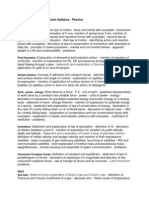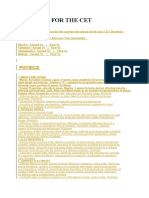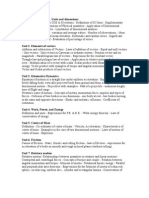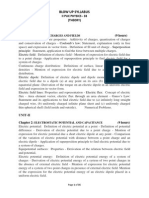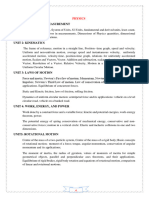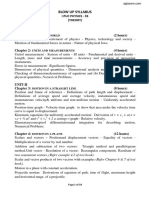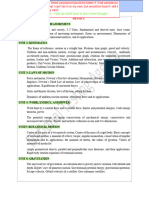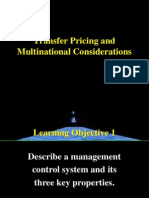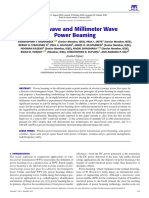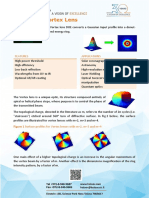Manipal Syllabus
Manipal Syllabus
Uploaded by
sunilmallCopyright:
Available Formats
Manipal Syllabus
Manipal Syllabus
Uploaded by
sunilmallCopyright
Available Formats
Share this document
Did you find this document useful?
Is this content inappropriate?
Copyright:
Available Formats
Manipal Syllabus
Manipal Syllabus
Uploaded by
sunilmallCopyright:
Available Formats
PHYSICS
DYNAMICS
Newtons laws of motion: First law of motion - force and inertia with examples -momentum - second
law of motion, derivation of F=ma, mention of spring force F=kx, mention of basic forces in nature -
impulse and impulsive forces with examples - second law as applied to variable mass situation - third
law of motion - Identifying action and reaction forces with examples - derivation of law of conservation
of momentum with examples in daily life - principle of rocket propulsion - inertial and non-inertial
frames - apparent weight in a lift and rocket/satellite - problems.
Fluid Dynamics: Explanation of streamline and turbulent motion - mention of equation of continuity -
mention of expressions for PE, KE and pressure energy of an element of a liquid flowing through a pipe -
statement and explanation of Bemoullis theorem and its application to uplift of an aircraft sprayer.
Surface tension: Concept of adhesive and cohesive forces - definition of Surface energy and surface
tension and angle of contact - explanation of capillary rise and mention of its expression - mention of
application of surface tension to (i) formation of drops and bubbles (ii) capillary action in wick of a lamp
(iii) action of detergents.
Work - power - energy: = 90o for a freely falling body - explanation of conservative and non
conservative forces with examples - explanation of elastic and inelastic collisions with examples -
coefficient of restitution - problems.uWork done by a force - F.S - unit of work - graphical representation
of work done by a constant and variable force - power - units of power - energy - derivation of
expression for gravitation potential energy and kinetic energy of a moving body - statement of work -
energy theorem - mention of expression for potential energy of a spring - statement and explanation of
law of conservation of energy - illustration in he case of a body sliding down on an inclined plane -
discussion of special case when
Gravitation: Statement and explanation of law of gravitation - definition of G - derivation of relation
between g and G - mention of expression for variation of g with altitude, depth and latitude - statement
and explanation of Keplers laws of planetary motion - definition of orbital velocity and escape velocity
and mention of their expressions - satellites - basic concepts of geo-stationary satellites, launching of
satellites - IRS and communication satellites - brief explanation of Inertial mass and gravitational mass -
weightlessness - remote sensing and essentials of space communication - problems.
Concurrent Co-plannar forces: Definition of resultant and equilibrant - statement of law of
parallelogram of forces - derivation of expression for magnitude and direction of two concurrent coplanar
forces - law of triangle of forces and its converse - Lamis theorem - problems.
HEAT
Gas laws: Statement and explanation of Boyles law and Charles law - definition of Pressure and
Volume Coefficient of a gas - absolute zero - Kelvin scale of temperature - mention of perfect gas
equation - explanation of isothermal and adiabatic changes - mention of Van-der-Waals equation of
state for real gases.
Mode of heat transfer: Conduction of heat - steady state - temperature gradient - definition of
coefficient of thermal conductivity - basic concepts of convection of heat - radiation - properties of
thermal radiation - radiant energy - definition of emissivity and absorptivity - perfect black body -
statement and explanation of Kirchhoffs law. Newtons law of cooling - Stefans law - Wiens
displacement and Plancks law - qualitative explanation of solar constant and surface temperature of sun
- principle and working of total radiation pyrometer - problems.
GEOMETRICAL OPTICS
Waves: Waves around us - brief note on light waves, sound waves, radio waves, micro waves, seismic
waves - wave as a carrier of energy - classification of waves. (i) based on medium - mechanical and
electromagnetic waves (ii) based on vibration of particles in the medium - Longitudinal & transverse
waves - one, two & to establish the relation between path difference and phase difference - definition of
a progressive wave - and its characteristics - derivation of equation of a progressive wave - different
forms of a progressive wave equation - definition of wave intensity - mention of expression of wave
intensity and its unit - statement and explanation of principles of superposition of waves with examples -
problems.three dimensional waves with example - definition of wave amplitude, wave frequency, wave
period, wavelength and wave velocity - concept of phase of a wave - derivation v=f
Sound: Properties of sound - speed of sound in a gas - explanation of Newtons formula for speed of
sound - correction by Laplace - Newton - Laplace formula - discussion of factors affecting speed i.e.
pressure, temperature, humidity and wind - definition of sound intensity - explanation of loudness and
its unit - definition of intensity level and its unit - mention of relation between intensity and loudness -
distinction between noise and musical note - characteristics of a musical note - phenomenon of beats
and its theory - application of beats (i) to find the frequency of a note (ii) to tune the musical
instruments -Doppler effect - derivation of expression for apparent frequency in general case and
discussion to special cases - qualitative comparison of Doppler effect in sound and light - problems.
Refraction at a plane surface: Refraction through a parallel sided glass slab - derivation of
expressions for lateral shift and normal shift (object in a denser medium) - total internal reflection and
its applications -optical fibers and its application in communication - problems.
Refraction through a prism: Derivation of expression for the refractive index in terms of A and D -
dispersion through a prism - experimental - arrangement for pure spectrum - deviation produced by a
thin prism - dispersive power - mention of condition for dispersion without deviation - problems.
Refraction at a spherical surface: Derivation of the relation - connecting n,u,v and r for refraction at
a spherical surface (concave towards a point object in a denser medium) derivation of lens makers
formula -power of a lens - magnification - derivation of expression for the equivalent focal length of
combination of two thin lenses in contact - mention of expression for equivalent focal length of two thin
lenses separated by a distance - problems.
PHYSICAL OPTICS
Introduction to Theories of Light: o, qualitative explanation of Hertzs experiment - brief explanation
of Plancks quantum theory of radiation -dual nature of light.co\A brief explanation of Newtons
corpuscular theory, Huygens wave theory and Maxwells electromagnetic theory - mention of expression
for speed of light C=1/
Interference: Explanation of the phenomenon theory of interference - derivation of conditions for
constructive and destructive interference.
Youngs double slit experiment, derivation of expression for fringe width - qualitative explanation of
interference at thin films and Newtons rings - problems.
Diffraction: Explanation of the phenomenon - distinction between Fresnel and Fraunhoffer diffraction -
qualitative explanation of diffraction at single slit and analysis of diffraction pattern (Fraunhoffer type) -
qualitative explanation of plane diffraction grating at normal incidence - limit of resolution - resolving
power - Rayleighs criterion - definition and mention of expression for resolving powers of microscope
and telescope - problems.
Polarisation: Explanation of the phenomenon - representation of polarized and unpolarised light -
explanation of plane of polarization and plane of vibration - methods of producing plane polarized light :
by reflection - Brewsters law, refraction, double refraction, selective absorption - construction and
application of polaroids - optical activity - specific rotatory power - construction and working of Laurents
half shade polarimeter - mention of circularly and elliptically polarized light - problems.
Speed of light: Michelsons rotating mirror experiment to determine of light - importance of speed of
light.
ELECTROSTATICS
Electric charges: Concept of charge - Coulombs law, absolute and relative permittivity - SI unit of
charge.
Electrostatic Field: Concept of electric field - definition of field strength - derivation of expression for
the field due to an isolated change, concept of dipole - mention of expression for the field due to a dipole
-definition of dipole moment - mention of expression for torque on a dipole - explanation of polarization
of a dielectric medium - dielectric strength - concept of lines of force and their characteristics -
explanation of electric flux - statement and explanation of Gauss theorem and its applications to derive
expressions for electric intensity (a) near the surface of a charged conductor (b) near a spherical
conductor - concept of electric potential - derivation of the relation between electric field and potential -
derivation of expression for potential due to an isolated charge - explanation of potential energy of a
system of charges - problems.
Capacitors: Explanation of capacity of a conductor and factors on which it depends - definition of
capacitance and its unit - derivation of expression for capacity of a spherical conductor - principle of a
capacitor - derivation of expression for capacitance of parallel plate capacitor - mention of expression for
capacitance of spherical and cylindrical capacitors - derivation of expression for energy stored in a
capacitor - derivation of expression for equivalent capacitance of capacitors in series and parallel -
mention of uses of capacitors - problems.
CURRENT ELECTRICITY
Electric current: d - deduction of Ofims law - origin of resistance - definition of resistivity -
temperature coefficient of resistance - concept of super conductivity - explanation of critical
temperature, critical field and high temperature superconductors - mention of uses of superconductors -
thermistors and mention of their uses - colour code for resistors -derivation of expression for effective
resistance of resistances in series and parallel -derivation of expression for branch currents - definition
of emf and internal resistance of a cell - Ohms law applied to a circuit -problems.vMicroscope view of
current through conductors (random motion of electrons) - explanation of drift velocity and mobility -
derivation of expression for current I = neA
Kirchoffs laws: Statement and explanation of Kirchoffs laws for electrical network - explanation of
Wheastones network - derivation of the condition for its balance by applying Kirchoffs laws - principle of
metre bridge - problems.
Magnetic effect of electric current: Magnetic field produced by electric current - statement and
explanation of Biot - Savarts (Laplaces) law - derivation of expression for magnetic field at any point on
the axis of a circular coil carrying current and hence expression for magnetic field at the centre - current
in a circular coil as a magnetic dipole - explanation of magnetic moment of the current loop - mention of
expression for the magnetic field due to (i) a straight current carrying conductor (ii) at a point on the
axis of a solenoid - basic concepts of terrestrial magnetism - statement and explanation of Tangent law -
construction and theory of tangent galvanometer - problems.
Mechanical effect of electric current: Mention of expression for force on a charge moving in
magnetic field - mention of expression for force on a conductor carrying current kept in a magnetic field
- statement of Flemings left hand rule - explanation of magnetic field strength in terms of flux density -
derivation of expression for the force between two parallel conductors carrying currents and hence
definition of ampere -mention of expression for torque on a current loop kept in an uniform magnetic
field - construction and theory of moving coil galvanometer - conversion of a pointer galvanometer into
an ammeter and voltmeter -problems.
Electromagnetic Induction: Statement explanation of Faradays laws of electromagnetic induction and
Lenzs law - derivation of expression for emf induced in a rod moving in a uniform magnetic field -
explanation of self induction and mutual induction - mention of expression for energy stored in a coil -
explanation of eddy currents - alternating currents - derivation of expression for sinusoidal emf -
definition of phase and frequency of ac - mention of the expression for instantaneous, peak, rms, and
average values -derivation of expression for current in case of ac applied to a circuit containing (i) pure
resistor (ii) inductor (iii) capacitor - derivation of expression for impedance and current in LCR series
circuit by phasor diagrm method - explanation of resonance - derivation of expression for resonant
frequency - brief account of sharpness of resonance and Q-factor - mention of expression for power in
ac circuits - power factor and wattless current - qualitative description of choke -basic ideas of magnetic
hysteresis - construction and working of transformers - mention of sources of power loss in transformers
- ac meters - principle and working of moving iron meter - qualitative explanation of transmission of
electrical power - advantages of ac and dc - problems.
ATOMIC PHYSICS
Introduction to atomic physics: Mention of the types of electron emission - description and theory of
Dunningtons method of finding e/m of an electron - explanation of types of spectra: emission and
absorption spectra - brief account of Fraunhoffer lines - qualitative explanation of electromagnetic
spectrum with emphasis on frequency.
Photo electric effect: Explanation of photo electric effect - experiment to study photo electric effect -
experimental observations - Einsteins photo electric equation and its explanation - principle and uses of
photo cells: (i) photo emissive (ii) photo voltaic (iii) photo conductive cells - problems.
Dual nature of matter: Concept of matter waves - arriving at the expression for de Brogile Wave
length -principle and working of G.P. Thomsons experiment - principle of Electron Microscope - Scanning
Electron Microscope Transmission Electron Microscope and Atomic -Force Microscope.
Bohrs Atom model: Bohrs atomic model for Hydrogen like atoms - Bohrs postulates - arriving at the
expressions for radius, velocity, energy and wave number - explanation of spectral series of Hydrogen -
energy level diagram - explanation of ionization and excitation energy - limitations of Bohrs theory -
qualitative explanation of Sommerfeld & Vector atom models - problems.
Scattering of light: Explanation of coherent and incoherent scattering - blue of the sky and sea - red at
sunrise and sunset - basic concepts and applications of Raman effect.
Lasers: Interaction between energy levels and electromagnetic radiation - laser action - population
inversion - optical pumping - properties of lasers - construction and working of Ruby laser - mention of
applications of lasers - brief account of photonics.
Nuclear Physics: Characteristics of nucleus - qualitative explanation of liquid drop model - qualitative
explanation of nuclear magnetic resonance (NMR) and its applications in medical diagnostics as MRI -
nuclear forces and their characteristics - explanation of Einsteins mass - energy relation - definition of
amu and eV - arriving at 1amu = 931 Mev - examples to show the conversion of mass into energy and
vice-versa - mass defect - binding energy - specific binding energy - BE curve - packing fraction.
Nuclear fission with equations - nuclear chain reaction - critical mass - controlled and un-controlled chain
reactions - types of nuclear reactors and mention of their principles - disposal of nuclear waste. Nuclear
fusion - stellar energy (carbon & proton cycles) - problems.
Radioactivity: - explanation of decay constant - derivation of expression for half life - mention of
expression for mean life - relation between half and mean life - units of activity: Bequerrel and Curie -
Artificial transmutation: Artificial radioactivity - radio isotopes and mention of their uses - brief account
of biological effects of radiations and safety measures - problems.Laws of radioactivity (i) Soddys
group displacement laws (ii) decay law - derivation of N=NOe-
Elementary particles: -decay - neutrino hypothesis and Quarks.|Basic concepts of leptons and
hadrons - qualitative explanation of
Solid state electronics: Qualitative explanation of Bond theory of solids - classification of conductors,
insulators and semiconductors - intrinsic and extrinsic semiconductors - p-type and n-type
semiconductors -construction and action of pn-junction - forward and reverse biasing - half wave and
full wave rectification -function and application of light emitting diodes - photo diode - laser diode -
transistors - npn and pnp transistors - action of transistor -npn transistor as an amplifier in CE mode.
Digital Electronics: Logic gates -AND, OR, NOR & NAND symbols and truth table - applications of logic
gates (Boolean equations) - half adder and full adder.
Soft condensed matter physics: Liquid crystals - classification, thermotropic ( nematic, cholesteric
and smectic) and lyotropic liquid crystals - mention of applications of liquid crystals - basic concepts of
emulsions, gels & foams.
CHEMISTRY
STOICHIOMETRY
Equivalent mass of elements - definition, principles involved in the determination of equivalent masses
of elements by hydrogen displacement method, oxide method, chloride method and inter conversion
method (experimental determination not needed). Numerical problems.
Equivalent masses of acids, bases and salts.
Atomic mass, Moleqular mass, vapour density-definitions. Relationship between molecular mass and
vapour density. Concept of STP conditions. Gram molar volume. Experimental determination of
molecular mass of a volatile substance by Victor Meyers method. Numerical problems.
Mole concept and Avogadro number, numerical problems involving calculation of: Number of moles when
the mass of substance is given, the mass of a substance when number of moles are given and number
of particles from the mass of the substance. Numerical problems involving mass-mass, mass-volume
relationship in chemical reactions.
Expression of concentration of solutions-ppm, normality, molarity and mole fraction. Principles of
volumetric analysis- standard solution, titrations and indicators-acid-base (phenolphthalein and methyl
orange) and redox (Diphenylamine). Numerical problems.
ATOMIC STRUCTURE
Introduction- constituents of atoms, their charge and mass.
Atomic number and atomic mass.
Wave nature of light, Electromagnetic spectrum-emission spectrum of hydrogen-Lyman series, Balmer
series, Paschen series, Brackett series and Pfund series. Rydbergs equation. Numerical problems
involving calculation of wavelength and wave numbers of lines in the hydrogen spectrum. Atomic model-
Bhors theory, (derivation of equation for energy and radius not required). Explanation of origin of lines
in hydrogen spectrum. Limitations of Bhors theory. Dual nature of electron- distinction between a
particle and a wave. de Broglies theory. Matter-wave equation (to be derived). Heisenbergs uncertainty
principle (Qualitative). Quantum numbers - n, l, m and s and their significance and inter relationship.
Concept of orbital- shapes of s, p and d orbitals. Paulis exclusion principle and aufbau principle. Energy
level diagram and (n+1) rule. Electronic configuration of elements with atomic numbers from 1 to 54.
Hunds rule of maximum multiplicity.
General electronic configurations of s, p and d block elements.
PERIODIC PROPERTIES
Periodic table with 18 groups to be used.
Atomic radii (Van der Waal and covalent) and ionic radii: Comparison of size of cation and anion with the
parent atom, size of isoelectronic ions. Ionization energy, electron affinity, electronegativity- Definition
with illustrations. Variation patterns in atomic radius, ionization energy, electron affinity,
electronegativity down the group and along the period and their interpretation.
OXIDATION NUMBER
Oxidation and reduction-Electronic interpretation.
Oxidation number: definition, rules for computing oxidation number. Calculation of the oxidation number
of an atom in a compound/ion.
Balancing redox equations using oxidation number method, calculation of equivalent masses of oxidising
and reducing agents.
GASEOUS STATE
GAS LAWS: Boyles Law, Charles Law, Avogadros hypothesis, Daltons law of partial pressures,
Grahams law of diffusion and Gay Lussacs law of combining volumes. Combined gas equation. Kinetic
molecular theory of gases-postulates, root mean square velocity, derivation of an equation for the
pressure exerted by a gas. Expressions for r.m.s velocity and kinetic energy from the kinetic gas
equation. Numerical problems. Ideal and real gases, Ideal gas equation, value of R (SI units). Deviation
of real gases from the ideal behaviour. PV-P curves. Causes for the deviation of real gases from ideal
behavior. Derivation of Van der Waals equation and interpretation of PV-P curves
CHEMICAL KINETICS
Introduction. Commercial importance of rate studies. Order of a reaction. Factors deciding the order of a
reaction-relative concentrations of the reactants and mechanism of the reaction. Derivation of equation
for the rate constant of a first order reaction. Unit for the rate constant of a first order reaction. Half-life
period. Relation between half-life period and order of a reaction. Numerical problems.
Determination of the order of a reaction by the graphical and the Ostwalds isolation method. Zero
order, fractional order and pseudo first order reactions with illustrations. Effect of temperature on the
rate of a reaction-temprature coefficient of a reaction. Arrhenius interpretation of the energy of
activation and temperature dependence of the rate of reaction. Arrhenius equation. Influence of catalyst
on energy profile. Numerical problems on energy of activation.
ORGANIC COMPOUNDS WITH OXYGEN-2, AMINES
Phenols:
Uses of phenol.
Classification: Mono, di and tri-hydric Phenols
Isolation from coal tar and manufacture by Cumene process.
Methods of preparation of phenol from - Sodium benzene sulphonate,Diazonium salts
Chemical properties:Acidity of Phenols-explanation using resonance-Effect of substituents on
Acidity(methyl group and nitro group as substituents), Ring substitution reactions-Bromination,
Nitration, Friedel-crafts methylation, Kolbes reaction, Reimer-Tiemann reaction.
Aldehydes and Ketones:
Uses of methanal,benzaldehyde and acetophenone
Nomenclature
General methods of preparation of aliphatic and aromatic aldehydes and ketones from Alcohols and
Calcium salts of carboxylic acids
Common Properties of aldehydes and ketones
a) Addition reactions with - Hydrogen cyanide, sodium bisulphate
b) Condensation reactions with-Hydroxylamine, Hydrazine, Phenyl hydrazine, Semicarbazide
c) Oxidation.
Special reactions of aldehydes:Cannizzaros reaction-mechanism to be discussed, Aldol condensation,
Perkins reaction, Reducing properties-with Tollens and Fehlings reagents.
Special reaction of ketones-Clemmensens reduction
Monocarboxylic Acids:
Uses of methanoic acid and ethanoic acid.
Nomenclature and general methods of preparation of aliphatic acids
From Alcohols, Cyanoalkanes and Grignard reagent
General properties of aliphatic acids: Reactions with - Sodium bicarbonate, alcohols, Ammonia,
Phosphorus pentachloride and soda lime
Strength of acids-explanation using resonance.
Effect of substituents (alkyl group and halogen as substituents)
Amines:
Uses of Aniline
Nomenclature Classification-Primary, Secondary, Tertiary-aliphatic and aromatic.
General methods of preparation of primary amines from - Nitro hydrocarbons, Nitriles(cyano
hydrocarbons), Amides(Hoffmanns degradation)
General Properties - Alkylation,Nitrous acid, Carbyl amine reaction, Acylation
Tests to distinguish between-Primary, secondary, Tertiary amines-Methylation method.
Interpretaion of Relative Basicity of-Methylamine, Ammonia and Aniline using inductive effect.
HYDROCARBONS-2
Stability of Cycloalkanes-Baeyers Strain theory-interpretation of the properties of Cycloalkanes, strain
less ring. Elucidation of the structure of Benzene - Valence Bond Theory and Molecular Orbital Theory.
Mechanism of electrophilic substitution reactions of Benzene-halogenations, nitration, sulphonation and
Friedel Crafts reaction.
HALOALKANES
Monohalogen derivaties:
Nomenclature and General methods of preparation from-Alcohols and alkenes.
, KCN, AgCN and aqueous KOH, with Magnesium, Wurtz reaction, Wurtz-Fittigs reaction, Friedal-Crafts
reaction3General properties of monohalogen derivatives: Reduction, with alcoholic KOH, Nucleophilic
substitution reactions with alcoholic NH
Mechanism of Nucleophilic Substitution reactions- SN1 mechanism of Hydrolysis of teritiary butyl
bromide and SN2 mechanism of Hydrolysis of methyl bromide.
COORDINATION COMPOUNDS
Co-ordination compound: Definition, complex ion, ligands, types of ligands-mono, bi, tri and polydentate
ligands. Co-ordination number, isomerism (ionization linkage, hydrate), Werners theory, Sidgwicks
theory, and E A N rule, Nomenclature of coordination, compounds.Valance Bond Theory: sp
3
, dsp
2
and
d
2
sp
3
hybridisation taking [Ni(Co)4], [Cu(NH3)4]SO4, K4[Fe(CN)6] respectively as examples.
CHEMICAL BONDING 2
Covalent bonding-molecular orbital theory :linear combination of atomic orbitals (Qualitative approach),
energy level diagram, rules for filling molecular orbitals, bonding and anti bonding orbitals, bond order,
electronic configuration of H2, Li2 and O2 Non existence of He2 and paramagnetism of O2.
Metallic bond: Electron gas theory (Electron Sea model), definition of metallic bond, correlation of
metallic properties with nature of metallic bond using electron gas theory.
CHEMICAL THERMODYNAMICS-2
Spontaneous and nonSpontaneous process. Criteria for spontaneity-tendency to attain a state of
minimum energy and maximum randomness. Entropy-Entropy as a measure of randomness, change in
entropy, unit of entropy. Entropy and spontaneity. Second law of thermodynamics. Gibbs free as a
driving force of a reaction Gibbs equation. Prediction of feasibility of a process in terms of G using
Gibbs equation. Standard free energy change and its relation to Kp(equation to be assumed). Numerical
problems.
SOLID STATE
Crystalline and amorphous solids, differences. Types of crystalline solids - covalent, ionic, molecular and
metallic solids with suitable examples. Space lattice, lattice points, unit cell and Co- ordination number.
Types of cubic lattice-simple cubic, body centered cubic, face centered cubic and their coordination
numbers. Calculation of number of particles in cubic unit cells. Ionic crystals-ionic radius, radius ratio
and its relation to co-ordination number and shape. Structures of NaCl and CsCl crystals.
ELECTROCHEMISTRY
Electrolytes and non electrolytes. Electrolysis-Faradays laws of electrolysis. Numerical problems.
Arrhenius theory of electrolytic dissociation, Merits and limitations. Specific conductivities and molar
conductivity-definitions and units. Strong and weak electrolytes-examples. Factors affecting
conductivity.
Acids and Bases: Arrhenius concept, limitations. Bronsted and Lowrys concept, merits and limitations.
Lewis concept, Strengths of Acids and Bases - dissociation constants of weak acids and weak bases.
Ostwalds dilution law for a weak electrolytes-(equation to be derived) - expression for hydrogen ion
concentration of weak acid and hydroxyl ion concentration of weak base - numerical problems.
. Applications of common ion effect and solubility product in inorganic qualitative analysis. Numerical
problems.2B and AB2. Relationship between solubility and solubility product of salts of types AB, A2B and
AB2Ionic product of water. pH concept and pH scale. pKa and pkb values-numerical problems. Buffers,
Buffer action, mechanism of buffer action in case of acetate buffer and ammonia buffer. Hendersons
equation for pH of a buffer(to be derived). Principle involved in the preparation of buffer of required pH-
numerical problems. Ionic equilibrium: common ion effect, solubility product, expression for Ksp of
sparingly soluble salts of types AB, A
Electrode potential: Definition, factors affecting single electrode potential. Standard electrode potential.
Nernsts equation for calculating single electrode potential (to be assumed). Construction of electro-
chemical cells-illustration using Daniel cell. Cell free energy change [Go =-nFEo (to be assumed)].
Reference electrode: Standard Hydrogen Electrode-construction, use of SHE for determination of SRP of
other single electrodes. Limitations of SHE.
Electrochemical series and its applications. Corrosion as an electrochemical phenomenon, methods of
prevention of corrosion.
ORGANIC CHEMISTRY
Inductive effect, Mesomeric effect and Electromeric effect with illustrations, Conversion of methane to
ethane and vice versa and Methanol to ethanol and vice versa
ISOMERISM-2
Stereo isomerism:geometrical and optical isomerism
Geometrical isomerism-Illustration using 2-butene, maleic acid and fumaric acid as example, Optical
Isomerism-Chirality, optical activity-Dextro and Laevo rotation(D and L notations).
CARBOHYDRATES
Biological importance of carbohydrates, Classification into mono, oligo and poly saccharides. Elucidation
of the open chain structure of Glucose. Haworths structures of Glucose, Fructose, Maltose and
Sucrose(elucidation not required).
OILS AND FATS
Biological importance of oils and fats, Fatty acids-saturated, unsaturated, formation of triglycerides.
Generic formula of triglycerides.
Chemical nature of oils and fats-saponification, acid hydrolysis, rancidity refining of oils, hydrogenation
of oils, drying oils, iodine value.
AMINO ACIDS AND PROTEINS
-Aminoacids - General formulaoBiological importance of proteins,
Formulae and unique feature of glycine, alanine, serine, cysteine, aspartic acid, lysine, tyrosine and
proline. Zwitter ion, amphiprotic nature, isoelectric point, peptide bond, polypeptides and proteins.
Denaturation of proteins
Structural features of Insulin - a natural polypeptide.
METALLURGY 2
Physico-chemical concepts involved in the following metallurgical operations -
Desilverisation of lead by Parkes process-Distribution law.
Reduction of metal oxides - Ellingham diagrams - Relative tendency to undergo oxidation in case of
elements Fe Ag, Hg, Al, C. Cr, and Mg.
Blast furnace - metallurgy of iron - Reactions involved and their role, Maintenance of the temperature
gradient, Role of each ingredient and Energetics
INDUSTRIALLY IMPORTANT COMPOUNDS:
Manufacture of Caustic soda by Nelsons cell Method, Ammonia by Habers process, Sulphuric acid by
Contact process and Potassium dichromate from chromite.
Uses of the above compounds.
Chemical properties of Sulphuric acid: Action with metals, Dehydrating nature, Oxidation reactions and
Reaction with PCI
Chemical properties of potassium dichromate: With KOH, Oxidation reactions, formation of chromyl
chloride.
GROUP 18, NOBEL GASES
Applications of noble gases. Isolation of rare gases from Ramsay and Raleighs method and separation of
individual gases from noble gas mixture (Dewars charcoal adsorption method).Preparation of Pt XeF6 by
Neil Bartlett.
d - BLOCK ELEMENTS (TRANSITION ELEMENTS)
Definition. 3d series: electronic configurations, size, variable oxidation states, colour, magnetic
properties, catalytic behaviour, complex formation and their interpretations.
THEORY OF DILUTE SOLUTIONS
Vant Hoffs theory of dilute Solutions. colligative property. Examples of colligative properties-lowering of
vapour pressure, elevation in boiling points, depression in freezing point and osmotic pressure.
Lowering of vapour pressure-Raoults law (mathematical form to be assumed). Ideal and non ideal
solutions (elementary idea) - measurement of relative lowering of vapour pressure-ostwald and Walkers
dymnamic method. Determination of molecular mass by lowering of vapour pressure). Numerical
problems.
COLLOIDS
Introduction. Colloidal system and particle size. Types of colloidal systems. Lyophilic and lyiphobic sols,
examples and differences. Preparation of sols by Bredigs arc method and peptisation. Purification of
sols-dialysis and electro dialysis. Properties of sols-Tyndall effect, Brownian movement electrophoresis,
origin of charge, coagulation, Hardy and Schulze rule, Protective action of sols. Gold number. Gold
number of gelatin and starch. Applications of colloids. Electrical precipitation of smoke, clarification of
drinking water and formation of delta.
MATHEMATICS - I
ALGEBRA
PARTIAL FRACTIONS
Rational functions, proper and improper fractions, reduction of improper fractions as a sum of a
polynomial and a proper fraction.
Rules of resolving a rational function into partial fractions in which denominator contains
(i) Linear distinct factors, (ii) Linear repeated factors, (iii) Non repeated non factorizable quadratic
factors [problems limited to evaluation of three constants].
LOGARITHMS
(i) Definition Of logarithm
(ii) Indices leading to logarithms and vice versa
(iii) Laws with proofs:
(a) logam+logan = loga(mn)
(b) logam - logan = loga(m/n)
(c) logamn = nlogam
(d) log b m = logam/logab (change of base rule)
(iv) Common Logarithm: Characteristic and mantissa; use of logarithmic tables,problems theorem
MATHEMATICAL INDUCTION
(i) Recapitulation of the n
th
terms of an AP and a GP which are required to find the general term of the
series
(ii) Principle of mathematical Induction proofs of
a. n =n(n+1)/2
b.n
2
=n(n+1)(2n+1)/6
c. n
3
= n
2
(n+1)
2
/4
By mathematical induction
Sample problems on mathematical induction
SUMMATION OF FINITE SERIES
(i) Summation of series using n, n
2
, n
3
(ii) Arithmetico-Geometric series
(iii) Method of differences (when differences of successive terms are in AP)
(iv) By partial fractions
THEORY OF EQUATIONS
(i) FUNDAMENTAL THEOREM OF ALGEBRA: An n
th
degree equation has n roots(without proof)
(ii) Solution of the equation x
2
+1=0.Introducing square roots, cube roots and fourth roots of unity
(iii) Cubic and biquadratic equations, relations between the roots and the co-efficients. Solutions of cubic
and biquadratic equations given certain conditions
(iv) Concept of synthetic division (without proof) and problems. Solution of equations by finding an
integral root between - 3 and +3 by inspection and then using synthetic division.
Irrational and complex roots occur in conjugate pairs (without proof). Problems based on this result in
solving cubic and biquadratic equations.
BINOMIAL THEOREM
Permutation and Combinations:
Recapitulation of
n
Pr and
n
Cr and proofs of
(i) general formulae for
n
Pr and
n
Cr
(ii)
n
Cr =
n
Cn-r
(iii)
n
Cr-1 +
n
C r =
n+1
C r
(1) Statement and proof of the Binomial theorem for a positive integral index by induction. Problems to
find the middle term(s), terms independent of x and term containing a definite power of x.
(2) Binomial co-efficient - Proofs of
(a) C 0 + C 1 + C 2 + ..+ C n = 2
n
(b) C 0 + C 2 + C 4 + ..= C 1+ C 3 + C 5 + 2
n - 1
MATHEMATICAL LOGIC
Proposition and truth values, connectives, their truth tables, inverse, converse, contrapositive of a
proposition, Tautology and contradiction, Logical Equivalence - standard theorems, Examples from
switching circuits, Truth tables, problems.
GRAPH THEORY
Recapitulation of polyhedra and networks
(i) Definition of a graph and related terms like vertices, degree of a vertex, odd vertex, even vertex,
edges, loop, multiple edges, u-v walk, trivial walk, closed walk, trail, path, closed path, cycle, even and
odd cycles, cut vertex and bridges.
(ii) Types of graphs: Finite graph, multiple graph, simple graph, (p,q) graph, null graph, complete
graph, bipartite graph, complete graph, regular graph, complete graph, self complementary graph,
subgraph, supergraph, connected graph, Eulerian graph and trees.
(iii) The following theorems: p
p
(1) In a graph with p vertices and q edges deg v i = 2 q
i=1
(2) In any graph the number of vertices of odd degree is even.
(iv) Definition of connected graph, Eulerian graphs and trees - simple probles.
ANALYTICAL GEOMETRY
1. Co-ordinate system
(i) Rectangular co-ordinate system in a plane (Cartesian)
(ii) Distance formula, section formula and mid-point formula, centroild of a triangle, area of a triangle -
derivations and problems.
(iii) Locus of a point. Problems.
2 .Straight line
(i)Straight line: Slope m = (tan) of a line, where is the angle made by the line with the positive x-
axis, slope of the line joining any two points, general equation of a line - derivation and problems.
(ii) Conditions for two lines to be (i) parallel, (ii) perpendicular. Problems.
(iii) Different forms of the equation of a straight line: (a) slope - point form (b) slope intercept form (c) two
points form(d) intercept form and (e) normal form - derivation; Problems.
(iv) Angle between two lines point of intersection of two lines condition for concurrency of three lines.
Length of the perpendicular from the origin and from any point to a line. Equations of the internal and
external bisectors of the angle between two lines- Derivations and Problems.
3. Pair of straight lines
(i) Pair of lines, homogenous equations of second degree. General equation of second degree. Derivation of
(1) condition for pair of lines (2) conditions for pair of parallel lines, perpendicular lines and distance
between the pair of parallel lines.(3) Condition for pair of co-incidence lines and (4) Angle and point of
intersection of a pair of lines.
LIMITS AND CONTINUTY
(1) Limit of a function - definition and algebra of limits.
(2) Standarad limits (with proofs)
(i) Lim x
n
- a
n
/x - a= na
n-1
(n rational)
xa
(ii) Lim sin / = 1 ( in radian) and Lim tan / = 1 ( in radian)
0 0
(3) Statement of limits (without proofs):
(i) Lim (1 + 1/n)
n
= e (ii) Lim (1 + x/n)
n
= e
x
n n
(iii) Lim (1 + x)
1/x
= e (iv) Lim log(1+x)/x = 1
x0 x0
v) Lim (e
x
- 1)/x= 1 vi) Lim (a
x
- 1)/x = logea
x0 x0
Problems on limits
(4) Evaluation of limits which tale the form Lim f(x)/g(x)[0/0 form] Lim f(n)/g(n)
x0 x
[ / form] where degree of f(n) degree of g(n). Problems.
(5) Continuity: Definitions of left- hand and right-hand limits and continuity. Problems.
TRIGONOMETRY
Measurement of Angles and Trigonometric Functions
Radian measure - definition, Proofs of:
(i) radian is constant
(ii) t radians = 180
0
(iii) s = r where is in radians
(iv) Area of the sector of a circle is given by A = r
2
where is in radians. Problems
Trigonometric functions - definition, trigonometric ratios of an acute angle, Trigonometric identities (with
proofs) - Problems.Trigonometric functions of standard angles. Problems. Heights and distances - angle of
elevation, angle of depression, Problems. Trigonometric functions of allied angles, compound angles,
multiple angles, submultiple angles and Transformation formulae (with proofs). Problems. Graphs of sinx,
cosx and tanx.
Relations between sides and angles of a triangle
Sine rule, Cosine rule, Tangent rule, Half-angle formulae, Area of a triangle, projection rule (with proofs).
Problems. Solution of triangles given (i) three sides, (ii) two sides and the included angle, (iii) two angles and
a side, (iv) two sides and the angle opposite to one of these sides. Problems.
MATHEMATICS - II
ALGEBRA
ELEMENTS OF NUMBER THEORY
(i) Divisibility - Definition and properties of divisibility; statement of division algorithm.
(ii) Greatest common divisor (GCD) of any two integers using Euclis algorithm to find the GCD of any two
integers. To express the GCD of two integers a and b as ax + by for integers x and y. Problems.
(iii) Relatively prime numbers, prime numbers and composite numbers, the number of positive divisors of a
number and sum of all positive division of a number - statements of the formulae without proofs. Problems.
(iv) Proofs of the following properties:
(1) the smallest divisor (>1) of an integer (>1) is a prime number
(2) there are infinitely many primes
(3) if c and a are relatively prime and c| ab then c|b
(4) if p is prime and p|ab then p|a or p|b
(5) if there exist integers x and y such that ax+by=1 then (a,b)=1
(6) if (a,b)=1, (a,c)=1 then (a,bc)=1
(7) if p is prime and a is any ineger then either (p,a)=1 or p|a
(8) the smallest positive divisor of a composite number a does not exceed a
Congruence modulo m - definition, proofs of the following properties:
(1) mod m" is an equivalence relation
(2) a b (mod m) => a x b x (mod m) and ax bx (mod m)
(3) If c is relatively prime to m and ca cb (mod m) then a b (mod m) - cancellation law
(4) If a b (mod m) - and n is a positive divisor of m then a b (mod n)
(5) a b (mod m) => a and b leave the same remainder when divided by m
Conditions for the existence of the solution of linear congruence ax b (mod m) (statement only), Problems
on finding the solution of ax b (mod m)
GROUP THEORY
Groups - (i) Binary operation, Algebraic structures. Definition of semigroup, group, Abelian group -
examples from real and complex numbers, Finite and infinite groups, order of a group, composition tables,
Modular systems, modular groups, group of matrices - problems.
(ii) Square roots, cube roots and fourth roots of unity from abelian groups w.r.t. multiplication (with proof).
(iii) Proofs of the following properties:
(i) Identity of a group is unique
(ii)The inverse of an element of a group is unique
(iii) (a
-1
)
-1
= a, a G where G is a group
(iv)(a*b)
-1
= b
-1
*a
-1
in a group
(v)Left and right cancellation laws
(vi)Solutions of a* x = b and y* a = b exist and are unique in a group
(vii)Subgroups, proofs of necessary and sufficient conditions for a subgroup.
(a) A non-empty subset H of a group G is a subgroup of G iff (i) a, b H, a*b H and (ii) For each
a H,a
-1
H (b) A non-empty subset H of a group G is a subgroup of G iff a, b H, a * b
-1
H. Problems.
VECTORS
(i) Definition of vector as a directed line segment, magnitude and direction of a vector, equal vectors, unit
vector, position vector of point, problems.
(ii) Two-and three-dimensional vectors as ordered pairs and ordered triplets respectively of real numbers,
components of a vector, addition, substraction, multiplication of a vector by a scalar, problems.
(iii) Position vector of the point dividing a given line segment in a given ratio.
(iv) Scalar (dot) product and vector (cross) product of two vectors.
(v) Section formula, Mid-point formula and centroid.
(vi) Direction cosines, direction ratios, proof of cos
2
+ cos
2
+cos
2
= 1 and problems.
(vii) Application of dot and cross products to the area of a parallelogram, area of a triangle, orthogonal
vectors and projection of one vector on another vector, problems.
(viii) Scalar triple product, vector triple product, volume of a parallelepiped; conditions for the coplanarity of
3 vectors and coplanarity of 4 points.
(ix) Proofs of the following results by the vector method:
(a) diagonals of parallelogram bisect each other
(b) angle in a semicircle is a right angle
(c) medians of a triangle are concurrent; problems
(d) sine, cosine and projection rules
(e) proofs of 1. sin(AB) = sinAcosBcosAsinB
2. cos(AB) = cosAcosB sinAsinB
MATRICES AND DETERMINANTS
(i) Recapitulation of types of matrices; problems
(ii) Determinant of square matrix, defined as mappings : M (2,R) R and :M(3,R) R. Properties of
determinants including (AB)=(A) (B), Problems.
(iii) Minor and cofactor of an element of a square matrix, adjoint, singular and non-singular matrices,
inverse of a matrix,. Proof of A(Adj A) = (Adj A)A = |A| I and hence the formula for A
-1
. Problems.
(iv) Solution of a system of linear equations in two and three variables by (1) Matrix method, (2)
Cramers rule. Problelms.
(v) Characteristic equation and characteristic roots of a square matrix. Cayley-Hamilton therorem
|statement only|. Verification of Cayley-Hamilton theorem for square matrices of order 2 only. Finding A
-
1
by Cayley-Hamilton theorem. Problems.
ANALYTICAL GEOMETRY
CIRCLES
(i) Definition, equation of a circle with centre (0,0) and radius r and with centre (h,k) and radius r.
Equation of a circle with (x1 ,y1) and (x2,y2) as the ends of a diameter, general equation of a circle, its
centre and radius - derivations of all these, problems.
(ii) Equation of the tangent to a circle - derivation; problems. Condition for a line y=mx+c to be the
tangent to the circle x
2
+y
2
= r
2
- derivation, point of contact and problems.
(iii) Length of the tangent from an external point to a circle - derivation, problems
(iv) Power of a point, radical axis of two circles, Condition for a point to be inside or outside or on a
circle - derivation and problems. Poof of the result the radical axis of two circles is straight line
perpendicular to the line joining their centres. Problems.
(v) Radical centre of a system of three circles - derivation, Problems.
(vi) Orthogonal circles - derivation of the condition. Problems
CONIC SECTIONS (ANANLYTICAL GEOMETRY)
Definition of a conic
1. Parabola
Equation of parabola using the focus directrix property (standard equation of parabola) in the form y
2
=
4 ax ; other forms of parabola (without derivation), equation of parabola in the parametric form; the
latus rectum, ends and length of latus rectum. Equation of the tangent and normal to the parabola y
2
=
4 ax at a point (both in the Cartesian form and the parametric form) (1) derivation of the condition for
the line y=mx+c to be a tangent to the parabola, y
2
= 4 ax and the point of contact. (2) The tangents
drawn at the ends of a focal chord of a parabola intersect at right angles on the directix - derivation,
problems.
2. Ellipse
Equation of ellipse using focus, directrix and eccentricity - standard equation of ellipse in the
form x
2
/a
2
+y
2
/b
2
= 1(a>b) and other forms of ellipse (without derivations). Equation of ellips in the
parametric form and auxillary circle. Latus rectum: ends and the length of latus rectum. Equation of the
tangent and the normal to the ellipse at a point (both in the cartesian form and the parametric form)
Derivations of the following:
(1) Condition for the line y=mx+c to be a tangrent to the ellipsex
2
/a
2
+y
2
/b
2
= 1 at (x1,y1) and finding
the point of contact
(2) Sum of the focal distances of any point on the ellipse is equal to the major axis
(3) The locus of the point of intersection of perpendicular tangents to an ellipse is a circle (director
circle)
3 Hyperbola
Equation of hyperbola using focus, directrix and eccentricity - standard equation hyperbola in the
form x
2
/a
2
-y
2
/b
2
= 1 Conjugate hyperbola x
2
/a
2
-y
2
/b
2
= -1 and other forms of hyperbola (without
derivations). Equation of hyperbola in the parametric form and auxiliary circle. The latus rectum; ends
and the length of latus rectum. Equations of the tangent and the normal to the hyperbola x
2
/a
2
-y
2
/b
2
=
1 at a point (both in the Cartesian from and the parametric form). Derivations of the following results:
(1) Condition for the line y=mx+c to be tangent to the hyperbola x
2
/a
2
-y
2
/b
2
= 1 and the point of
contact.
(2) Differnce of the focal distances of any point on a hyperbola is equal to its transverse axis.
(3) The locus of the point of intersection of perpendicular tangents to a hyperbola is a circle (director
circle)
(4) Asymptotes of the hyperbola x
2
/a
2
-y
2
/b
2
= 1
(5) Rectangular hyperbola
(6) If e1 and e2 are eccentricities of a hyperbola and its conjugate then 1/e1
2
+1/e
2
2=1
TRIGONOMETRY
COMPLEX NUMBERS
(i) Definition of a complex number as an ordered pair, real and imaginary parts, modulus and amplitude
of a complex number, equality of complex numbers, algebra of complex numbers, polar form of a
complex number. Argand diagram, Exponential form of a complex number. Problems.
(ii) De Moivres theorem - statement and proof, method of finding square roots, cube roots and fourth
roots of a complex number and their representation in the Argand diagram. Problems.
DIFFERENTIATION
(i) Differentiability, derivative of function from first principles, Derivatives of sum and difference of
functions, product of a constant and a function, constant, product of two functions, quotient of two
functions from first principles. Derivatives of Xn , e x, a x, sinx, cosx, tanx, cosecx, secx, cotx, logx from
first principles, problems.
(ii) Derivatives of inverse trigonometric functions, hyperbolic and inverse hyperbolic functions.
(iii) Differentiation of composite functions - chain rule, problems.
(iv) Differentiation of inverse trigonometric functions by substitution, problems.
(v) Differentiation of implicit functions, parametric functions, a function w.r.t another function,
logarithmic differentiation, problems.
(vi) Successive differentiation - problems upto second derivatives.
APPLICATIONS OF DERIVATIVES
(i) Geometrical meaning of dy\dx, equations of tangent and normal, angle between two curves.
Problems.
(ii) Subtangent and subnormal. Problems.
(iii) Derivative as the rate measurer. Problems.
(iv) Maxima and minima of a function of a single variable - second derivative test. Problems.
INVERSE TRIGONOMETRIC FUNCTIONS
(i) Definition of inverse trigonometric functions, their domain and range. Derivations of standard
formulae. Problems.
(ii) Solutions of inverse trigonometric equations. Problems.
GENERAL SOLUTIONS OF TRIGONOMETRIC EQUATIONS
General solutions of sinx = k, cosx=k, (-1 k 1), tanx = k, acosx+bsinx= c - derivations. Problems.
INTEGRATION
(i) Statement of the fundamental theorem of integral calculus (without proof). Integration as the reverse
process of differentiation. Standarad formulae. Methods of integration, (1) substitution, (2) partial
fractions, (3) integration by parts. Problems.
(4) Problems on integrals of:
1/(a+bcosx); 1/(a+bsinx); 1/(acosx+bsinx+c); 1/asin2x+bcos2x+c; [f(x)]n f ' (x);
f'(x)/ f(x); 1/(a2 - x2 ) ; 1/( x2 - a2); 1/( a2 + x2); 1/x ( x2 a2 ) ; 1/ (x2 - a2);
( a2 x2); ( x2- a2 ); px+q/(ax2+bx+c; px+q/(ax2+bx+c); pcosx+qsinx/(acosx+bsinx); ex[f(x)
+f1 (x)]
DEFINITE INTEGRALS
(i) Evaluation of definite integrals, properties of definite integrals, problems.
(ii) Application of definite integrals - Area under a curve, area enclosed between two curves using
definite integrals, standard areas like those of circle, ellipse. Problems.
DIFFERENTIAL EQUATIONS
Definitions of order and degree of a differential equation, Formation of a first order differential equation,
Problems. Solution of first order differential equations by the method of separation of variables,
equations reducible to the variable separable form. General solution and particular solution. Problems.
GENERAL ENGLISH
Broadly, this paper includes questions on general English like spotting of errors, sentence improvement,
vocabulary etc.
You might also like
- Kostuk Holography Principles and ApplicationsDocument349 pagesKostuk Holography Principles and ApplicationsEder Manuel Alfaro Alfaro estNo ratings yet
- 16 TOFD Evaluation GuidelineDocument17 pages16 TOFD Evaluation GuidelineMohamed Ibrahim100% (1)
- Enat O9 - : Physics - Part IDocument20 pagesEnat O9 - : Physics - Part Iajithlal_k_k1758No ratings yet
- Manipal UGET 2014 Exam Syllabus - Physics: Dynamics Newton's Laws of MotionDocument20 pagesManipal UGET 2014 Exam Syllabus - Physics: Dynamics Newton's Laws of MotionPranjal GuptaNo ratings yet
- Manipal SyllabusDocument17 pagesManipal Syllabusveenu68No ratings yet
- Syllabus For The Cet: PhysicsDocument17 pagesSyllabus For The Cet: PhysicsSyed ZabiNo ratings yet
- KLUEEESyllabusDocument18 pagesKLUEEESyllabusBigflower9155 BNo ratings yet
- Physics Syllabus: Unit 1. Units and DimensionsDocument5 pagesPhysics Syllabus: Unit 1. Units and Dimensionschinna12kumarNo ratings yet
- Kcet PortionsDocument15 pagesKcet PortionsShashank RamakrishnanNo ratings yet
- Physics SyllabusDocument5 pagesPhysics SyllabussijeeshNo ratings yet
- pdhaiDocument20 pagespdhaineetaspirant086No ratings yet
- New Syllabus Physics Ug STDDocument4 pagesNew Syllabus Physics Ug STDstickee65No ratings yet
- Physics I ST Grade 12122013Document6 pagesPhysics I ST Grade 12122013mittalnipun2009No ratings yet
- Revised Syllabus CBCSS-FDP Physics-2014Document28 pagesRevised Syllabus CBCSS-FDP Physics-2014ADWAITH SNo ratings yet
- MSC Entrance Syllabus-Physics - 0Document4 pagesMSC Entrance Syllabus-Physics - 0yazh iniNo ratings yet
- SyllabusDocument4 pagesSyllabusSanthana KaruppuNo ratings yet
- Emrs Physics SyllabusDocument4 pagesEmrs Physics SyllabusNscience freakNo ratings yet
- VITEEE 2023 Physics SyllabusDocument2 pagesVITEEE 2023 Physics SyllabusAgony busterNo ratings yet
- Viteee - 2020 - Physics 1. Laws of Motion & Work, Energy and PowerDocument2 pagesViteee - 2020 - Physics 1. Laws of Motion & Work, Energy and PowerAaditya KannanNo ratings yet
- Vitee SyllabusDocument8 pagesVitee Syllabusmamtakalra3632No ratings yet
- VITEEE 2024 SyllabusDocument10 pagesVITEEE 2024 Syllabussaikatsarkar409No ratings yet
- AP EdCET Syllabus and Exam PatternDocument28 pagesAP EdCET Syllabus and Exam PatterngayathriNo ratings yet
- Joint Entrance Examination (Main) - 2023: PhysicsDocument5 pagesJoint Entrance Examination (Main) - 2023: PhysicsLakshya SinghiNo ratings yet
- 1C8BDF22-8FED-4D2C-B109-810BF969E936Document6 pages1C8BDF22-8FED-4D2C-B109-810BF969E936ashvinilata2002No ratings yet
- NTA Updated JEE Main Physics Syllabus 2024Document3 pagesNTA Updated JEE Main Physics Syllabus 2024tejashishsawleNo ratings yet
- B.Sc. Part-I Paper-I Mechanics, Oscillations and Properties of Matter (Paper Code 0793)Document17 pagesB.Sc. Part-I Paper-I Mechanics, Oscillations and Properties of Matter (Paper Code 0793)playergghazlian173No ratings yet
- Physics VITEEE2025Document2 pagesPhysics VITEEE2025mithunesh001No ratings yet
- B Tech Barch 2919 SylDocument19 pagesB Tech Barch 2919 SylMukhtar AhmedNo ratings yet
- Blow Up Syllabus: Unit-I (9 Hours)Document35 pagesBlow Up Syllabus: Unit-I (9 Hours)Arham JainNo ratings yet
- Oavs PGTPhysicsDocument5 pagesOavs PGTPhysicsPragyan GiriNo ratings yet
- Physics Blown-Up Syllabus 1st PU.Document19 pagesPhysics Blown-Up Syllabus 1st PU.Milan MenezesNo ratings yet
- Including Link HTTPSWWW - JagranjoshDocument4 pagesIncluding Link HTTPSWWW - Jagranjoshsujithchalla12No ratings yet
- Neetu g 2025Document10 pagesNeetu g 2025humaap200025No ratings yet
- Syllabus: B.Sc. Pass (PHYSICS) : Pure Science (Pass) (Code - 46pure Science (Pass) (CDocument3 pagesSyllabus: B.Sc. Pass (PHYSICS) : Pure Science (Pass) (Code - 46pure Science (Pass) (CTottal RcksNo ratings yet
- PC SyllabusDocument11 pagesPC SyllabusRaunak KumarNo ratings yet
- JEE Main 2024 Physics SyllabusDocument5 pagesJEE Main 2024 Physics Syllabussardarrohan765No ratings yet
- School of Aeronautics Entrance Examination Syllabus: Syllabus For Physics 1: Units and MeasurementDocument9 pagesSchool of Aeronautics Entrance Examination Syllabus: Syllabus For Physics 1: Units and Measurementquami3quartsNo ratings yet
- Iit Jee Main SyllabusDocument25 pagesIit Jee Main SyllabusIITIAN SANJEEV[IITK]No ratings yet
- NEET 2024 Physics Revised SyllabusDocument6 pagesNEET 2024 Physics Revised Syllabusvaidsakshi43No ratings yet
- NEET UG 2024 - Approved - Final - RemovedDocument13 pagesNEET UG 2024 - Approved - Final - Removedyadav2007princeNo ratings yet
- Std12 Phy EM 1Document253 pagesStd12 Phy EM 1Saalinraj SantharajNo ratings yet
- Jcece Syllabus 201235376Document7 pagesJcece Syllabus 201235376Nikhil KumarNo ratings yet
- Syllabus For Written Examination For PGT (Physics) : Unit I: Physical World and MeasurementDocument3 pagesSyllabus For Written Examination For PGT (Physics) : Unit I: Physical World and MeasurementTapabrata DamNo ratings yet
- West Bangal State University: Syllabus B.Sc. (General) - PHYSICSDocument8 pagesWest Bangal State University: Syllabus B.Sc. (General) - PHYSICSRikta DasNo ratings yet
- Physics Syllabus For Jee Mains 2018Document5 pagesPhysics Syllabus For Jee Mains 2018Addhyan TiwariNo ratings yet
- Wbjee PhysicsDocument2 pagesWbjee PhysicsPinaki BiswasNo ratings yet
- JU EE SyllabusDocument45 pagesJU EE Syllabusmenilanjan89nLNo ratings yet
- PH 110 Course OutlineDocument4 pagesPH 110 Course OutlineeugeneNo ratings yet
- Physics - Pastpaper For CssDocument12 pagesPhysics - Pastpaper For Cssdanyalhaider222333No ratings yet
- SAEEE Physics SyllabusDocument4 pagesSAEEE Physics Syllabusanujars5410% (1)
- SYLLABUSDocument45 pagesSYLLABUSsherlockNo ratings yet
- Syllabus For Written Examination For PGT (Phy) : Unit I: Physical World and MeasurementDocument14 pagesSyllabus For Written Examination For PGT (Phy) : Unit I: Physical World and MeasurementLingarajuhyd RamaNo ratings yet
- JKCET SyllabusDocument14 pagesJKCET SyllabusAnweshaBoseNo ratings yet
- AISEE Syllabus EngineeringDocument12 pagesAISEE Syllabus Engineeringsudheer chandraNo ratings yet
- Department of Physics and Electronics B.Sc. (Physics)Document12 pagesDepartment of Physics and Electronics B.Sc. (Physics)621 605ManishNo ratings yet
- Blow Up Syllabus: I Puc Physics - 33 (Theory) Unit-I (2 Hours)Document19 pagesBlow Up Syllabus: I Puc Physics - 33 (Theory) Unit-I (2 Hours)Adithya SRKianNo ratings yet
- JEE (Main) Physics Syllabus: UNIT 1: Physics and MeasurementDocument7 pagesJEE (Main) Physics Syllabus: UNIT 1: Physics and Measurementmajji satishNo ratings yet
- STD 9 Phy Plan 2013-14Document2 pagesSTD 9 Phy Plan 2013-14SarvashreshthaPatelNo ratings yet
- PhysicsDocument5 pagesPhysicsamazon audibleNo ratings yet
- Problems in Quantum Mechanics: Third EditionFrom EverandProblems in Quantum Mechanics: Third EditionRating: 3 out of 5 stars3/5 (2)
- Case Laws IBC ACAE SeminarDocument23 pagesCase Laws IBC ACAE SeminarsunilmallNo ratings yet
- Implication of Supreme Court Verdict On Provident FundDocument9 pagesImplication of Supreme Court Verdict On Provident FundsunilmallNo ratings yet
- Transfer Pricing and Multinational ConsiderationsDocument60 pagesTransfer Pricing and Multinational ConsiderationssunilmallNo ratings yet
- Frequently Asked Questions: Compounding of Contraventions Under FEMA, 1999Document7 pagesFrequently Asked Questions: Compounding of Contraventions Under FEMA, 1999sunilmallNo ratings yet
- Power Deals 2009 All DealsDocument15 pagesPower Deals 2009 All Dealsnitinaggarwal.naNo ratings yet
- Major Challenges in Audiing ERP SecurityDocument3 pagesMajor Challenges in Audiing ERP SecuritysunilmallNo ratings yet
- Physical Science - Module 7Document35 pagesPhysical Science - Module 7joegie petalvoNo ratings yet
- Kcet 2018 Answer Keys by Expert Coaching Classes PDFDocument41 pagesKcet 2018 Answer Keys by Expert Coaching Classes PDFPrashanth GNo ratings yet
- Phy-102 Physics BSC Aircraft Maintenance Engineering IndexDocument108 pagesPhy-102 Physics BSC Aircraft Maintenance Engineering Index74015No ratings yet
- Applied ElectronicsDocument110 pagesApplied ElectronicsRahul CP100% (1)
- Chap01 Science Answer KeyDocument34 pagesChap01 Science Answer Keydearonalmeida12100% (4)
- 1-10 1016@j Optcom 2019 125015Document11 pages1-10 1016@j Optcom 2019 125015Miguel UgarteNo ratings yet
- GP Thompson ExperimentDocument8 pagesGP Thompson ExperimentHemanth GoliNo ratings yet
- Physics Unit 2Document142 pagesPhysics Unit 27csnty5wvgNo ratings yet
- Barrier Insertion Loss Measurements: Report OnDocument35 pagesBarrier Insertion Loss Measurements: Report OnKevin BiltonNo ratings yet
- F Fxe DX: Sin QDocument3 pagesF Fxe DX: Sin QSang Min LeeNo ratings yet
- Physics L.O. 1 Term Grade 12 - 2021: Harmonic Motion and WavesDocument7 pagesPhysics L.O. 1 Term Grade 12 - 2021: Harmonic Motion and WavesMahmoud EbaidNo ratings yet
- Microwave and Millimeter Wave Power BeamingDocument31 pagesMicrowave and Millimeter Wave Power BeamingMonkeyFromMarsNo ratings yet
- ABET em 2 SyllabusDocument7 pagesABET em 2 SyllabusmuktikantaNo ratings yet
- Vortex Lens: Features ApplicationsDocument2 pagesVortex Lens: Features ApplicationsDu RoyNo ratings yet
- 1st Sem Mid Term PYQs 2018&2019Document20 pages1st Sem Mid Term PYQs 2018&2019Sujeet RaiNo ratings yet
- Topsizer Product InformationDocument8 pagesTopsizer Product InformationJavier Hortencio Gonzales SamaméNo ratings yet
- June 2016 QP - Component 2 WJEC Physics AS-levelDocument16 pagesJune 2016 QP - Component 2 WJEC Physics AS-levelfadi baqainNo ratings yet
- Physics Lab 11mse1081Document12 pagesPhysics Lab 11mse1081anji_dmm1No ratings yet
- Basics of X-Ray Diffraction: Dr.J.Devarajju Assistant Professor (SS) Department of Geosciences Coes-Upes Dehra DunDocument70 pagesBasics of X-Ray Diffraction: Dr.J.Devarajju Assistant Professor (SS) Department of Geosciences Coes-Upes Dehra DunHimanshu PunethaNo ratings yet
- Ut Ravi Book NewDocument171 pagesUt Ravi Book NewPrakasa Spectro CastNo ratings yet
- AshishGarg Rietveld PDFDocument46 pagesAshishGarg Rietveld PDFMohamed Elwi MitwallyNo ratings yet
- Class 33: Outline: Hour 1: InterferenceDocument38 pagesClass 33: Outline: Hour 1: Interferenceakirank1No ratings yet
- Apperture NADADocument23 pagesApperture NADAJoseNo ratings yet
- Lorawan Gateways Coverage Optimization: Michel GilbertDocument49 pagesLorawan Gateways Coverage Optimization: Michel GilbertEneraldo Castellanos DiazNo ratings yet
- Chapter 1 Waves 1.1 Understanding Waves ( / 25 X 100 % ) Learning OutcomesDocument18 pagesChapter 1 Waves 1.1 Understanding Waves ( / 25 X 100 % ) Learning OutcomesBin HadithonNo ratings yet
- Centurion University of Technology and Management Odisha: B.Tech. in Electrical and Electronics EngineeringDocument269 pagesCenturion University of Technology and Management Odisha: B.Tech. in Electrical and Electronics EngineeringAjit SinhaNo ratings yet
- Dewi Kurnia (60400118035) - Jurnal JFT Panjang Gelombang CahayaDocument13 pagesDewi Kurnia (60400118035) - Jurnal JFT Panjang Gelombang CahayaDewi KurniaNo ratings yet
- JNTUA B.tech - Civil Engineering R23 I II Year Course Structure and SyllabusDocument102 pagesJNTUA B.tech - Civil Engineering R23 I II Year Course Structure and Syllabuskarthikarthi1weNo ratings yet



